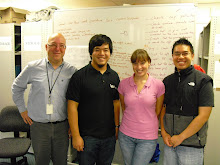Kiaora. Welcome to the Live Sculptures blog site. The ‘Live Sculptures and Soft Machines’ team consists of me, KatyPie, with Emilio Calius and Chee Kit Wong. Helping us with engineering support is Tokushu Inamura. So who are we and what are we doing?
I’m an artist, with a special interest in Maori kowhaiwhai designs. I like to create my own stories with the language of the design. Emilio is a senior scientist in Future Materials & Structures team at IRL and Kit also works at IRL and is a research scientist, specialising in robotics and spatial cognition. Tocky is an Auckland university Biomimetics Laboratory design engineer and DE manufacturing process specialist. Phew.
We were brought together by the Smash Palace grant, provided by Creative New Zealand in partnership with the Ministry of Research, Science and Technology (MoRST). This fund is to support collaboration between artists and scientists on an art project. We want to exploit artificial muscle actuation and sensing technologies to inject the breath of life into my art through motion.
In the union of art and science, we will use EAP technology to make my original Maori kowhaiwhai (painted designs) come alive. EAP are being actively studied for applications in bio-engineering and bio-robotics because of their potential for mimicking the movements of live beings. When electrically stimulated, polymers that can shrink, expand or change shape are classified as electro-active polymers (EAP) and are also known as artificial muscles because their characteristics are closer to that of biological muscle than any other smart material or conventional actuation technology. When a large electric field is applied, charge attractions and repulsions give rise to significant planar expansion and thickness contraction. In KatyPie speak, that means a polymer membrane that has been stretched onto a plastic frame, is coated on both sides with a black grease in various designs. Electrodes are added and charge applied. The membrane tenses and relaxes as the charge flows, causing the black grease designs to shrink and grow. As you can see in our first video, the designs appear to pulse.
The application of self actuating robotic materials to Kowhaiwhai design is a novel method for connecting the past to the present, which we believe will give people a deeper regard for the traditional by presenting it in a modern way.
Ultimately we aim to create an active sculpture for exhibition at public art galleries nationwide.
For the first couple of months of the project I will be trained how to use the new technology. This should be interesting! I am usually pretty capable with different kinds of materials and tools, but this is a whole new thing altogether. Stick with me and I’ll let you know how I get on.
Thanks so much for joining us on our journey. Comments, questions, and ideas are all welcome.
Hei konei ra,
KatyPie.
Short video of the first movements of our first 2-dimensional trial piece.
9/10/09
First day in the lab! We got straight down to business and created a planer dielectric elastomer (DE) motor. The hardest part of building this was stretching the VHB. This is a very viscose polymer. If I cut out a piece that is 5cm by 5cm, I can stretch it to 3 or four times the size. The problem is keeping the VHB intact while I make it bigger. I used the ‘iris’ and the ‘umbrella’ tools for stretching. I like the umbrella. I think it took 2 or 3 tries to stick the Perspex frame onto the VHB before it broke. It will get easier as I go on – I hope! I also stuck a Perspex ring to the centre of the membrane.
I adhered the copper tape electrodes easily enough then started painting the grease. That was actually harder than I thought it would be. You can’t apply too much pressure to the membrane or it might tear. And you can’t slide a dry brush over the surface or it will tear. All this while holding it dextrously in one hand.
After painting, the DE motor was ready to go. I painted 3 segments of the membrane. These expand and shrink in sequence, causing the ring in the middle to move. We could connect a crank in the middle to make it turn. The main thing is that I made my first actuating DE!
-KatyPie



No comments:
Post a Comment